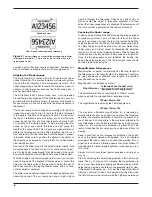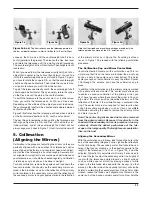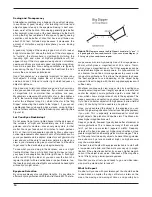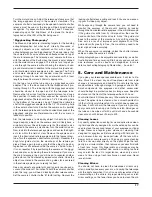
6
amount. If you suffer from severe astigmatism, however, you
may find images noticeably sharper with your glasses on.
Aligning the Finder Scope
The AstroView 6 EQ comes with a 6x30 achromatic finder
scope (Figure 2a). The number 6 means six-times magnifica-
tion and the 30 indicates a 30mm diameter front lens. The
finder scope makes it easier to locate the subject you want to
observe in the telescope, because the finder scope has a
much wider field-of-view.
The AstroView 6 EQ’s finder scope uses a spring-loaded
bracket that makes alignment of the finderscope very easy. As
you turn either of the thumbscrews, the spring in the bracket’s
tensioner moves in and out to keep the finder scope secure in
the bracket.
The finder scope must be aligned accurately with the tele-
scope for proper use. To align it, first aim the main telescope
in the general direction of an object at least a 1/4 mile away-
the top of a telephone pole, a chimney, etc. To aim the tele-
scope, loosen the R.A. and Dec. lock levers and move it until
it is pointing at the desired object. To help in aiming the tele-
scope, put your eye next to the tube and sight along the
length of the optical tube. This will give you a general idea of
where the telescope is pointing. Then retighten the R.A. and
Dec. lock levers. Turn the focus knob until the object is proper-
ly focused. Make sure to position the object in the center of
the telescope’s eyepiece by turning the R.A. and declination
slow-motion controls.
Now look in the finder scope. Is the object visible? Ideally it will
be somewhere in the field of view. If not, some coarse adjust-
ment to the finder scope bracket’s thumbscrews will be need-
ed until the object comes into the finder scope’s field of view.
With the image in the finder scope’s field of view, you will now
need to fine-adjust the alignment thumbscrews to center the
object on the intersection of the crosshairs. Adjust the aim of
the finder scope by turning the thumbscrews, one at a time,
until the object is centered.
The finder scope alignment needs to be checked before every
observing session. This can easily be done at night, before
viewing through the telescope. Choose any bright star or
planet, center the object in telescope eyepiece, and then
adjust the finder scope bracket’s alignment thumbscrews until
the star or planet is centered on the finder’s crosshairs.
Focusing the finder scope
If, when you look through the finder scope, the images appear
somewhat out of focus, you will need to refocus the finder
scope for your eyes. Loosen the lock ring located behind the
objective lens cell on the body of the finder scope (see Figure
2a). Back the lock ring off by a few turns, for now. Refocus the
finder scope on a distant object by threading the objective
lens cell in or out of the finderscope body. Precise focusing
will be achieved by focusing the finder scope on a bright star.
Once the image appears sharp, retighten the locking ring
behind the objective lens cell. The finder scope’s focus should
not need to be adjusted again.
Magnification & Eyepieces
Magnification, or power, is determined by the focal length of
the telescope and the focal length of the eyepiece. Therefore,
by using eyepieces of different focal lengths, the resultant
magnification can be varied.
Magnification is calculated as follows:
Telescope Focal Length (mm)
Magnification = ———————————————
Eyepiece Focal Length (mm)
The AstroView 6 EQ has a focal length of 750mm, which
when used with the supplied 25mm eyepiece yields:
750mm÷25mm=30x
The magnification provided by the 10mm eyepiece is:
750mm÷10mm=75x
The maximum attainable magnification for a telescope is
directly related to how much light it can gather. The larger the
aperture, the more magnification is possible. In general a fig-
ure of 50x per inch of aperture is the maximum attainable for
most telescopes. Your AstroView 6 EQ has an aperture of 6
inches, so the maximum magnification is about 300x. This
level of magnification assumes you have ideal conditions for
viewing.
Keep in mind that as you increase magnification, the bright-
ness of the object viewed will decrease; this is an inherent
principle of the laws of physics and cannot be avoided. If mag-
nification is doubled, an image appears four times dimmer. If
magnification is tripled, image brightness is reduced by a fac-
tor of nine!
Always start with your lowest power eyepiece and work your
way up.
Start by centering the object being viewed in the 25mm eye-
piece. Then, you may want to increase the magnification to
get a closer view. Before changing eyepieces, make sure the
object being viewed is centered in the eyepiece field of view.
If the object is off-center (i.e., it is near the edge of the field of
view) you will lose it when you increase magnification since
the field of view will be narrower with the higher-powered eye-
Naked-eye view
View through finder scope and telescope
Figure 4.
The view through a standard finder scope and reflector
telescope is rotated 180°. This is true for the AstroView 6 and its
finder scope as well.
Summary of Contents for AstroView 6 EQ 9827
Page 19: ...19 ...





























